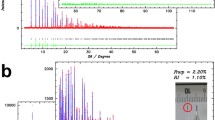Abstract
Based on density function theory (DFT) and the local density approximation (LDA), the formation energy and transition levels of native point defects in LaBr3 were calculated under Br-rich conditions. From the calculated results, the following conclusions have been obtained: ① The dominant defect type is the triply positive lanthanum interstitial under p-type conditions. ② The triply negative lanthanum vacancy plays the most important role in n-type LaBr3. ③ Neutral and singly positive bromine antisites are more stable in the middle of the band gap. ④ The singly positive (negative) bromine antisite can be a potential compensation source in n-type (p-type) LaBr3. ⑤ All the transition levels in LaBr3 belong to deep levels. The optimized geometric structures of bromine interstitials and antisites show that there is no formation of Br-Br covalent bond.
Similar content being viewed by others
References
Åberg D, Sadigh B, Erhart P. Electronic structure of LaBr3 from quasiparticle self-consistent GW calculations [J]. Phys Rev B, 2012, 85: 134–145.
Gao X, He Y J. The Research Progress of LaBr3: Ce3+ Scintillator Crystal [J]. Nuclear Electronics & Detection Technology, 2010, 30(1): 8–14 (Ch).
Canning A, Chaudhry A, Boutchko R, et al. First-principles study of luminescence in Ce-doped inorganic scintillators [J]. Phys Rev B, 2011, 83: 115–126.
Seifert S, Van Dam H T, Huizenga J, et al. Monolithic LaBr3: Ce crystals on silicon photomultiplier arrays for time-of-flight positron emission tomography [J]. Phys Med Biol, 2012, 57: 2219–2233.
Gao X, Bai X N, Chen Y B, et al. Positron annihilation life spectrometer with LaCl3:Ce3+ scintillator crystal [J]. Nuclear Electronics & Detection Technology, 2007, 27(2): 243–249 (Ch).
Van de Walle C G, Neugebauer J. First-principles calculations for defects and impurities: Applications to III-nitrides [J]. Applied Physics Reviews, 2004, 95(8): 3851–3879.
Anderson J, Van de Walle C G. Native point defects in ZnO [J]. Phys Rev B, 2007, 76: 202–217.
Schollhammer G, Herzig P. First-principles study of the solid solution of hydrogen lanthanum [J]. Phys Rev B, 2011, 84: 122–134.
Erhart P, Klein A, Albe K. First-principles study of the structure and stability of oxygen defects in zinc oxide [J]. Phys Rev B, 2005, 72: 213–220.
Xie J J, Yang P Z, Liao J Y. Progress on LnX3 scintillator crystals [J]. Journal of Inorganic Materials, 2005, 20(3): 522–528.
Liu B, Gu M, Qi Z M, et al. First-principles study of lattice dynamics and thermodynamic properties of LaCl3 and LaBr3 [J]. Phys Rev B, 2007, 76: 307–313.
Vonnegut B, Warren B E. The structure of crystalline bromine [J]. J Am Chem Soc, 1936, 58(12): 2459–2461.
Rycerz L, Ingier-Stocka E, Ziolek B, et al. Heat capacity and thermodynamic properties of LaBr3 at 300–1100 K [J]. A Journal of Physical Sciences, 2004, 59(11): 825–828.
Neugebauer J, Van de Walle C G. Atomic geometry and electronic structure of native defects in GaN [J]. Phys Rev B, 1994, 50(11): 8067–8070.
Author information
Authors and Affiliations
Corresponding author
Additional information
Foundation item: Supported by the National Nature Science Foundation of China (11275142)
Biography: ZHOU Guifang, female, Master candidate, research direction: structure and phase transition of defects in conductors.
Rights and permissions
About this article
Cite this article
Zhou, G., Liu, L. & Wang, Z. Formation energy of native point defects in LaBr3 . Wuhan Univ. J. Nat. Sci. 19, 106–110 (2014). https://doi.org/10.1007/s11859-014-0985-5
Received:
Published:
Issue Date:
DOI: https://doi.org/10.1007/s11859-014-0985-5




